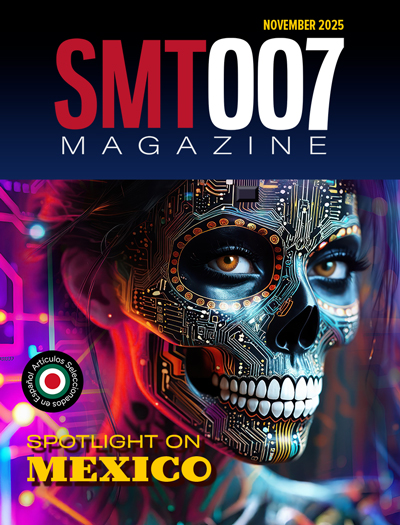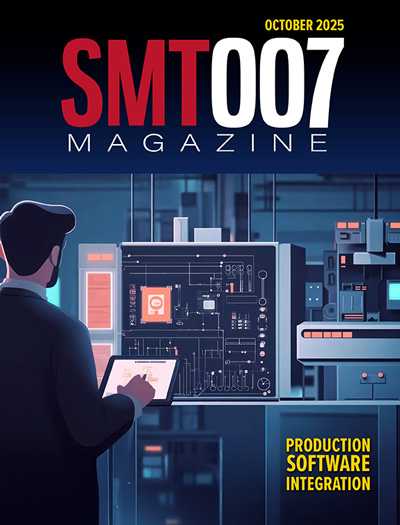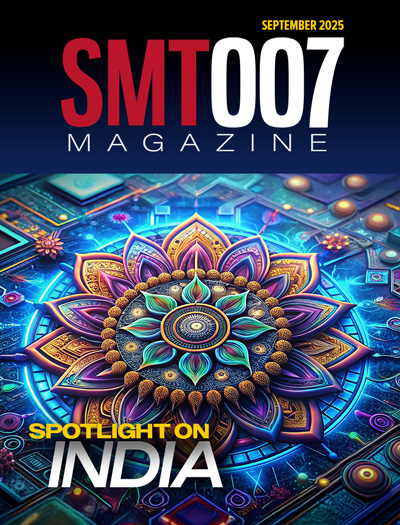-

- News
- Books
Featured Books
- smt007 Magazine
Latest Issues
Current Issue
Spotlight on Mexico
Mexico isn’t just part of the electronics manufacturing conversation—it’s leading it. From growing investments to cross-border collaborations, Mexico is fast becoming the center of electronics in North America. This issue includes bilingual content, with all feature articles available in both English and Spanish.

Production Software Integration
EMS companies need advanced software systems to thrive and compete. But these systems require significant effort to integrate and deploy. What is the reality, and how can we make it easier for everyone?

Spotlight on India
We invite you on a virtual tour of India’s thriving ecosystem, guided by the Global Electronics Association’s India office staff, who share their insights into the region’s growth and opportunities.
- Articles
- Columns
- Links
- Media kit
||| MENU - smt007 Magazine
First 2D Material Performs as Both Topological Insulator and Superconductor
November 1, 2018 | MITEstimated reading time: 6 minutes
A transistor based on the 2-D material tungsten ditelluride (WTe2) sandwiched between boron nitride can switch between two different electronic states — one that conducts current only along its edges, making it a topological insulator, and one that conducts current with no resistance, making it a superconductor — researchers at MIT and colleagues from four other institutions have demonstrated.
Image Caption: In two-dimensional tungsten ditelluride, two different states of matter — topological insulator and superconductor — can be chosen at will, MIT researchers discovered. Graphic: Sanfeng Wu
Using four-probe measurements, a common quantum electronic transport technique to measure the electronic behavior of materials, the researchers plotted the current carrying capacity and resistance characteristics of the two-dimensional tungsten ditelluride transistor and confirmed their findings across a range of applied voltages and external magnetic fields at extremely low temperatures.
“This is the first time that the exact same material can be tuned either to a topological insulator or to a superconductor,” says Pablo Jarillo-Herrero, the Cecil and Ida Green Professor of Physics at MIT. “We can do this by regular electric field effect using regular, standard dielectrics, so basically the same type of technology you use in standard semiconductor electronics.”
New Class of Materials
“This is the first of a new class of materials — topological insulators that can be tuned electrically into superconductors — which opens many possibilities which before there were significant obstacles to realize,” Jarillo-Herrero says. “Having one material where you can do this seamlessly within the same material to transition between this topological insulator and superconductor is something which is potentially very attractive.”
Tungsten ditelluride, which is one of the transition metal dichalcogenide materials, is classified as a semimetal and conducts electricity like metals in bulk form. The new findings detail that in a single-layer crystal form, at temperatures from less than 1 kelvin to liquid nitrogen range (-320.4 degrees Fahrenheit), tungsten ditelluride hosts three distinct phases: topologically insulating, superconducting, and metallic. An applied voltage drives the transition between these phases, which vary with temperature and electron concentration. In superconducting materials, electrons flow without resistance generating no heat.
The new findings have been published online in the journal Science. Valla Fatemi PhD '18, who is now a postdoc at Yale, and postdoc Sanfeng Wu, who is a Pappalardo Fellow at MIT, are co-first authors of the paper with senior author Jarillo-Herrero. The co-authors are MIT graduate student Yuan Cao; Landry Bretheau PhD '18 of the École Polytechnique in France; Quinn D. Gibson of the University of Liverpool in the UK; Kenji Watanabe and Takashi Taniguchi of the National Institute for Materials Science in Japan; and Robert J. Cava, a professor of chemistry at Princeton University.
Like a Quantum Wire
The new work builds on a report earlier this year by the researchers demonstrating the quantum spin Hall effect (QSH), which is the signature physics phenomenon underlying two-dimensional topological insulators, in the same single layer tungsten ditelluride material. This edge current is governed by the spin of the electrons rather than by their charge, and electrons of opposite spin move in opposite directions. This topological property is always present in the material at cold temperatures.
This quantum spin Hall effect persisted up to a temperature of about 100 kelvins (-279.67 degrees F). “So it’s the highest temperature 2-D topological insulator so far,” says postdoc Sanfeng Wu, who also was a first author of the earlier paper. “It’s very important for an interesting quantum state like this to survive at high temperatures for use for applications.”
This behavior, in which the edges of tungsten ditelluride material act like a quantum wire, was predicted in 2014 in a theoretical paper by associate professor of physics Liang Fu and Ju Li, a professor of nuclear science and engineering and materials science and engineering. Materials with these qualities are sought for spintronic and quantum computing devices.
Although the topological insulating phenomenon was observed at up to 100 kelvins, the superconducting behavior in the new work occurred at a much lower temperature of about 1K.
This material has the advantage of entering the superconducting state with one of the lowest densities of electrons for any 2-D superconductor. “That means that that small carrier density that is needed to make it a superconductor is one that you can induce with normal dielectrics, with regular dielectrics, and using a small electric field,” Jarillo-Herrero explains.
Addressing the findings of topological insulating behavior in 2-D tungsten telluride in the first paper, and the findings of superconductivity in the second, Wu says, “These are twin papers, each of them is beautiful and put together their combination can be very powerful.” Wu suggests that the findings point the way for investigation of 2-D topological materials and could lead the way to a new material basis for topological quantum computers.
The tungsten ditelluride crystals were grown at Princeton University, while the boron nitride crystals were grown at the National Institute for Materials Science in Japan. The MIT team built the experimental devices, carried out the electronic transport measurements at ultra-cold temperatures, and analyzed the data at the Institute.
Page 1 of 2
Testimonial
"The I-Connect007 team is outstanding—kind, responsive, and a true marketing partner. Their design team created fresh, eye-catching ads, and their editorial support polished our content to let our brand shine. Thank you all! "
Sweeney Ng - CEE PCBSuggested Items
Sealed for Survival: Potting Electronics for the Toughest Environments
10/29/2025 | Beth Massey, MacDermid Alpha Electronics SolutionsElectronics deployed in harsh conditions face relentless threats from vibration, impact, chemical contaminants, airborne pollutants, and moisture, conditions that can quickly lead to failure without robust protection. Potting, the process of encapsulating electronics in a protective polymer, is a widely used strategy to safeguard devices from both environmental and mechanical hazards.
Driving Innovation: Mechanical and Optical Processes During Rigid-flex Production
10/28/2025 | Kurt Palmer -- Column: Driving InnovationRigid-flex printed circuit boards are a highly effective solution for placing complex circuitry in tight, three-dimensional spaces. They are now indispensable across a range of industries, from medical devices and aerospace to advanced consumer electronics, helping designers make the most efficient use of available space. However, their unique construction—combining rigid and flexible materials—presents a fundamental challenge for PCB manufacturers.
SMTAI 2025 Review: Reflecting on a Pragmatic and Forward-looking Industry
10/27/2025 | Marcy LaRont, I-Connect007Leaving the show floor on the final afternoon of SMTA International last week in Rosemont, Illinois, it was clear that the show remains a grounded, technically driven event that delivers a solid program, good networking, and an easy space to commune with industry colleagues and meet with customers.
ITW EAE Despatch Ovens Now Support ASTM 5423 Testing
10/15/2025 | ITW EAEAs the demand for high-performance electrical insulation materials continues to grow—driven by the rapid expansion of electric vehicles (EVs) and energy storage systems—thermal processing has become a critical step in material development.
Beyond Thermal Conductivity: Exploring Polymer-based TIM Strategies for High-power-density Electronics
10/13/2025 | Padmanabha Shakthivelu and Nico Bruijnis, MacDermid Alpha Electronics SolutionsAs power density and thermal loads continue to increase, effective thermal management becomes increasingly important. Rapid and efficient heat transfer from power semiconductor chip packages is essential for achieving optimal performance and ensuring long-term reliability of temperature-sensitive components. This is particularly crucial in power systems that support advanced applications such as green energy generation, electric vehicles, aerospace, and defense, along with high-speed computing for data centers and artificial intelligence (AI).


